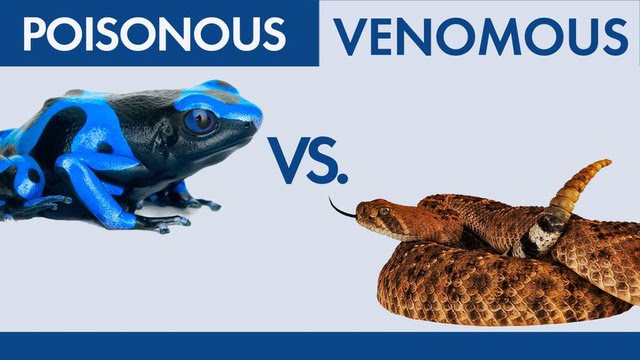Quck answer
The terms “venomous” and “poisonous” are often used interchangeably, but they actually have different meanings. Venomous organisms, such as snakes and spiders, inject their toxins into their prey or predators through a bite or sting. Poisonous organisms, such as certain plants and mushrooms, release their toxins when they are touched or ingested. In other words, venom is injected, while poison is ingested or absorbed through the skin. It’s important to know the difference, especially when dealing with potentially dangerous animals or plants.
Animal Facts

When encountering a snake, many people may ask if it is poisonous. However, this may not be the correct term to use as few snakes are actually poisonous. The correct term may be venomous. This article aims to clarify the difference between the two terms and provide information to win the argument venomous vs. poisonous. Although both terms involve toxic substances, the way they are delivered makes the difference.
Venomous vs. Poisonous Animals
Venomous animals and poisonous animals both have toxic substances that cause physical effects, but they differ in how they deliver their toxins. Poisonous animals require to be bitten or touched to deliver their toxin, like the poison dart frog. Venomous animals have to bite or sting for the toxin to enter the body, like snakes and spiders. Poisonous animals and mushrooms are usually brightly colored as a warning to predators, while venomous animals have active delivery systems.
Not all toxins are the same, and some animals just taste bad due to toxins in their diet. However, others have deadly toxins that cause extreme pain and serious damage to the nervous system.
The Most Toxic Animals

While there are few poisonous snakes, most snakes are venomous. The platypus is also venomous, with males having spurs on their ankles to inject venom into predators. Some animals, like the blue ringed octopus and the Asian tiger snake, are both venomous and poisonous. The latter has special glands in its neck that release the toxins of poisonous toads it eats, as well as venomous fangs located at the rear of the mouth. Mongooses, on the other hand, are not toxic but are skilled at handling toxins, allowing them to eat venomous snakes like cobras.
Now that you have learned something new, you may have figured out the truth. Cobras are venomous, not poisonous. Therefore, when a mongoose eats a cobra, it is consuming the cobra’s toxin, which is broken down by the acids in the mongoose’s stomach. Additionally, the mongoose can tolerate a small amount of snake venom.
Even plants can be classified as poisonous or venomous. Poison ivy, for example, is correctly named because its toxin is spread by simply touching its leaves. Stinging nettles can be considered venomous, if we are being generous with the term, because they deliver their irritating toxin through spines.
Now, here’s something gross: there is a third way toxins can be delivered, called toxungen. This method involves spitting or spraying the toxin at the enemy. Although it is a small category, it does include one well-known stinker: the skunk.
Originally Published: Jun 5, 2020
FAQ
1. What is the difference between venomous and poisonous?
Venomous and poisonous are often used interchangeably, but they actually have different meanings. Venom is a toxin that is injected into another organism, usually through a bite or sting. Venomous animals, like snakes or spiders, use their venom for hunting or defense. Poison, on the other hand, is a substance that is ingested, inhaled, or absorbed through the skin. Poisonous plants or animals, like poison ivy or dart frogs, have toxins that can cause harm if touched or eaten.
2. Can venomous animals also be poisonous?
Yes, some animals can be both venomous and poisonous. For example, the skin of some venomous snakes, like the poison dart frog, can also be poisonous if touched. However, not all venomous animals are poisonous and vice versa. It depends on the specific animal and its method of toxin delivery.
3. How can you tell if an animal is venomous or poisonous?
It can be difficult to tell if an animal is venomous or poisonous just by looking at it. It’s best to do your research before encountering any potentially dangerous animals or plants. Generally, venomous animals have specialized fangs, stingers, or spines for delivering their venom. Poisonous plants or animals often have bright colors or distinctive markings to warn predators to stay away.
4. What are some common examples of venomous and poisonous animals?
Examples of venomous animals include snakes, spiders, scorpions, and some species of fish and amphibians. Examples of poisonous plants and animals include poison ivy, poison oak, poison sumac, and some species of mushrooms, frogs, and insects.
5. What should you do if you are bitten or exposed to a venomous or poisonous animal or plant?
If you are bitten or exposed to a venomous or poisonous animal or plant, seek medical attention immediately. Do not wait for symptoms to appear, as some toxins can cause severe reactions that require immediate treatment. In the meantime, try to stay calm and keep the affected area still to slow the spread of the toxin. If possible, take a picture or description of the animal or plant to help medical professionals identify the specific toxin.





Leave a Reply